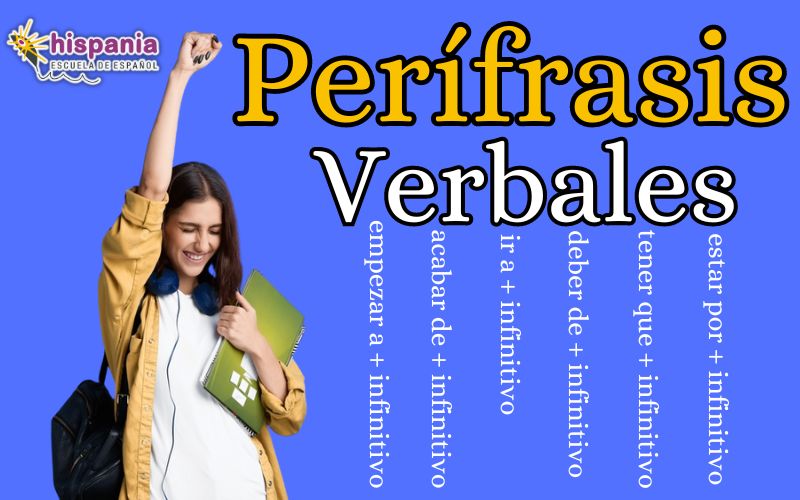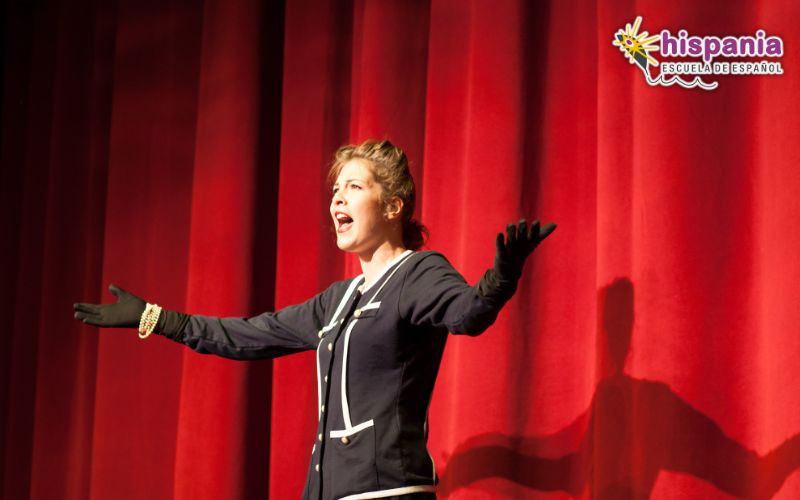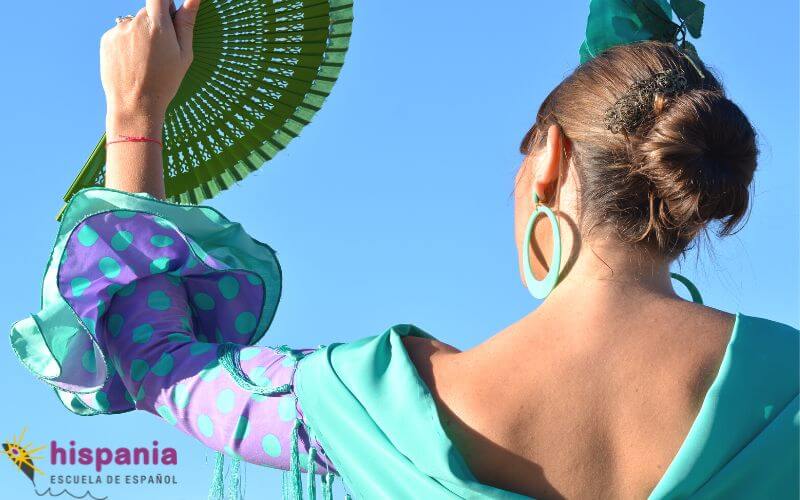
Flamenco: origins and characteristics
Do you like dancing?
I love it. 😁
Today we are going to learn a lot about the most famous Spanish dance: flamenco.
¡Olé! 💃
Origins of flamenco
We all know which country flamenco comes from.
It's pretty obvious, isn't it?
Spain, of course. 😃
So,Where does flamenco dance come from? exactly?
The flamenco originated in Andalusia in the XNUMXth century.
There are theories that claim that the dances name comes from the Arabic saying: 'Fellah min gueir ard', literally translated to 'landless farmer'.
Flamenco emerged as a fusion of dances and musical styles from many cultures. The dance is influenced by African, Andalusian, Jewish, Caribbean cultures and above all from the flamenco gypsy dance.
Originally, the people who sang and danced flamenco came from humble or poor social backgrounds, and used this form of art to express their emotions.
Therefore, even to this day, most of the lyrics are still very dramatic.
However, almost all flamenco dances finish with a optimistic ending that lightens any painful undertones.
Along with flamenco there are others traditional dances in Spain that in this article we tell you.
How flamenco dance has changed over time
So, what does a flamenco dance look like?
In order to answer this question, first we need to take a look at flamenco in general.
To start of with flamenco was only expressed through song.
Little by little, dancestarted to become incorporated into the songs, which was heavily influenced by African beats.
Eventually, music was added.
The most popular instruments used in Flamenco are the string guitar and the castanets.
Although, a very important part of the music is made by using the palms of the hands or with the feet using the heels of the flamenco shoe.
Since its creation in the XNUMXth century to the present day, flamenco spread across Spain as well as slowly reaching other countries.
Nowadays it is known all over the world and practically almost every country has a flamenco dance school.
In fact, flamenco has been officially recognised by UNESCO as an important pillar to Cultural Heritage in 2010.
So, why was flamenco so successful?
Most likely, it's success is due to flamenco being one of the most passionate musical styles to exist.
Flamenco dances and songs are based on emotions such as love, heartbreak, grief, sadness, joy or despair. Flamenco is always highly emotionally charged .
Nowadays, flamenco has turned into an extremely versatile genre, as it is often merged with totally different genres such as rock, pop and even rap.
These fusions have made way for very interesting flamenco dance songs.
Have you never seen a flamenco show?
Well, you already have a plan for next weekend!
Your emotions will be running sky high. 😉
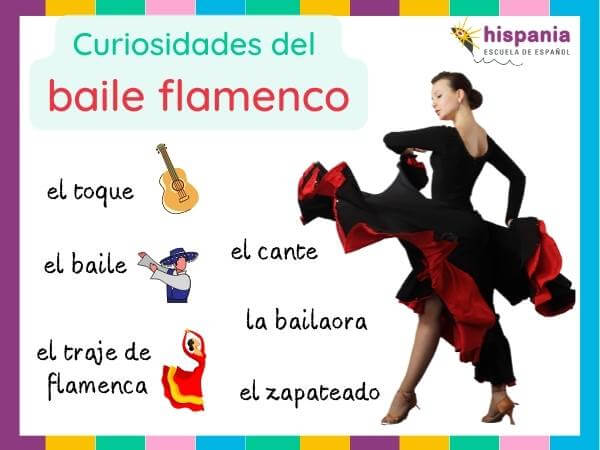
Interesting facts about flamenco
Let's take a look at some interesting facts about flamenco, I know you're going to love them.
Did you know that the song Is it usually performed individually and whilst seated?
Furthermore, the style remains the same for both men and women.
The musical accompaniment to the dance or song is called el toque, and like I mentioned before, the main instrument used is the guitar.
Sometimes there are long guitar solos, that aren't accompanied by singing or dancing. The acoustic guitar is the height of Spanish instrumental excellence.
That's why they call it the Spanish guitar, right?
One of the most iconic Spanish flamenco guitarists was Paco de Lucía.
At our school, Hispania, escuela de español, everyday we start classes with one of his most famous songs: 'Entre dos aguas’ (Between two waters).
Therefore, students at our school can learn Spanish on our Spanish courses whilst listening to some of the best Spanish music around.
It's practically a two for the price of one! 😁
Would you like to know who the best flamenco dancers are?
There's been many such as: Sara Baras, Joaquín Cortés, La Lupi, Antonio Canales...
Here’s a video of the impressive Joaquin Cortes, one of my favourite and most avant-garde dancers that there is.
What does a flamenco costume look like?
Additionally to what we have already looked at, another interesting aspect of flamenco and something that attracts many people to view the show is the flamenco costume. .
The women wear a flamenco dress. There are many different styles, but the most popular style is a long floor length dress.
The flamenco dress has frilled sleeves and a frilled skirt.
The colour of the dress is usually very vibrant, like red.
The design can be plain, patterned or polka dot.
Typical accessories include a Manila shawl (manton de Manila) worn around the shoulders, flowers in the hair, large earrings, and high heels.
Some dancers like to embellish their moves with flamenco dance fans.
The flamenco dresses are truly amazingand give a strong presence to any woman who wears one.
Men also wear a flamenco costume called a 'traje corto flamenco'.
Typically the costume consists of a white shirt , pants with white turn ups, sometimes a short jacket, tall cowboy boots and chaps.
Finally, as an accessory men usually wear a wide brim hat.
Originally it was considered a farming uniform designed to work with livestock.
This, however, is the traditional costume and today many flamenco dancers wear modern suits with shirts and ties. The most typical colors are black or white.
Has reading this made you want to sign up for dance classes at a flamenco school?
I'm sure the costume would look great on you! 😊
Flamenco characteristics
What are the characteristics of flamenco?
Let me tell you...
Men usually perform more aggressive and strong dances, above all using the heel of the professional flamenco shoe.
Whereas, women tend to move the body and arms more, sometimes making more sensual movements.
Stomping is the essence of flamenco dancing. The dancers o dancers not only dance but become musicians by hitting their shoes against the ground.
Each part of the shoe creates a different sound depending on which part of the foot is struck: the sole, the ball or the heel.
The dancers they master the body posture, rhythms and speed required for flamenco dance.
The dancers interpret feelings of the singers (cantaor or cantaora).
They adapt the rhythm of their hips and shoulders, arm movements and stomping to the song.
They combine soft movements with stronger steps and turns.
They do not follow strict dance routines, but concentrate on emitting the feelings projected by the singers.
Therefore, there is often a lot of improvisationin flamenco, the same song will rarely ever be interpreted the same way twice.
There is usually only one bailaor or bailaora although sometimes there are two.
When there are two dancers, the show become even more emotive.
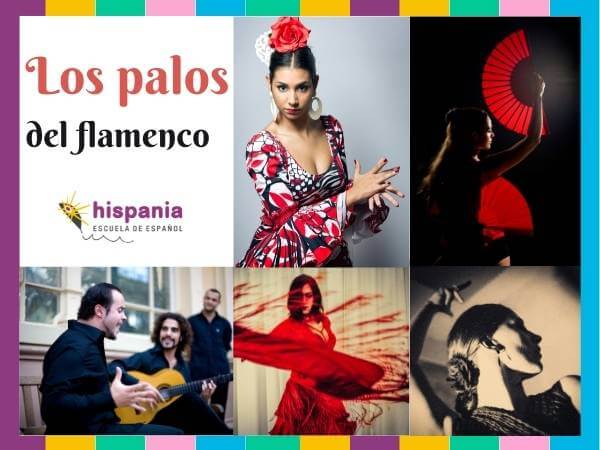
Styles of flamenco
There are many different styles of flamenco. The variety of styles are called 'palos'.
There are more than 50 different 'palos'.
Want to hear them all?
I'm sorry, but if I told you about every single style of flamenco the article would be so long that you would need a whole day to read it. 😂
How about I summarise the seven most popular flamenco styles Spanish celebrations?
So, when you finish reading this article, you will have a general idea of how the different styles of flamenco are danced .
¡Vamos a verlos!
Soleá
Soleá style flamenco is usually performed as a solo dance. soloists The first women to preform a Soleá was Maria La Andonda.
This style allows dancers to show off all different types of moves. The dancers' attitude is expressive yet serious .
The beat is usually slow and solemn.
There are subgenres that exist within the genre soleá: the soleá of Triana, the soleá from Cádiz, the soleá from Jerez, and many more.
Bulerías
The genre 'bulerías' is typically a vibrant, happy and festive style. They are very popular in Andalusian cities such as Jerez de la Frontera, Utrera and Cádiz.
It's 12-beat make it one of the most complicated flamenco dances to execute.
To express the fun and festive rhythm, the artists have to be versatile and good at improvising.
Bulerías are most commonly performed at the end of the flamenco party, where the members gather in semicircles and come out one by one, dancing, cheering and clapping.
At video you can watch an example of a bulería performed as part of a choreographed flamenco dance.
Alegrías
What do you think this flamenco dance is like? Sad or happy?
It's pretty obvious, right? 😃
It’s own name makes it pretty clear. Alegrías use fast paced, upbeat rhythm in which the dance plays a fundamental role to the celebration.
Just like the Bulerías, there's never a lack of partying going on at the Alegrías
One of the most distinctive elements of the dance is its beginning which is started with the specific song: tirititrán.
It is a 12-beat dance like in the bulerías, but even faster.
Dancing Alegrías flamenco is great fun.
Seguiriyas
Seguiriyas are one of the most dramatic, serious and sentimental types of dance.
It is also one of the oldest forms of flamenco.
They are usually accompanied by a funeral song.
The main themes are suffering within relationships, fear of death and painful love.
Unlike with previous genres, dancers barely decorate their costumes.
Some popular Seguiriyas are 'Frasco el Colorao' or 'la Niña de los peines' .
Tangos
If I say tango, what is the first thing that comes to mind?
The popular Argentine tango, right?
Well, truthfully we don't know if the tango comes from South America or from Andalusia.
There are theories that confirm that it originated in Cádiz and Seville and later spread to the South American continent.
Other theories argue that it was created in Cuba and then traveled to Spain, Europe and America.
The truth is that tango is one of the oldest forms of flamenco.
In general, it is a cheerful and lively dance.
Some of the pioneering artists in this style were El Mellizo, Pastora Pavón, El Titi and La Repompa.
Farruca
Farruca it is one of the most recent forms of flamenco. By the XNUMXth century it was already gaining a lot of popularity.
One of the most interesting things about this style is that there are sources that link it's origins to the north of Spain such as, Asturias and Galicia.
In the dance, it is common to raise the arms above the head and display firm control of the moves in an elegant and calm manner.
Tap dance is key to this dance. Therefore, it is usually performed by more men than women.
Faíco founded the Farrucas.
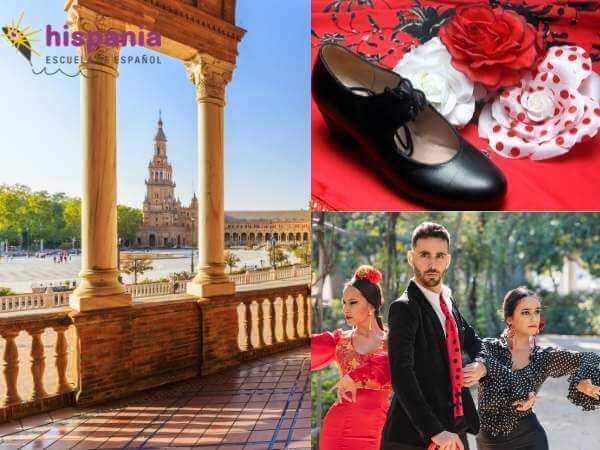
Sevillanas
Let's take a look at the final style of flamenco.
What do yo think about our article? Have you enjoyed it?
I'm already thinking about buying a short flamenco costume and signing up to a dance school. 😁
Sevillanas is probably the most well known style of flamenco.
In fact, it could be considered the most popular folkloric dance in all of Spain.
Perhaps the key to its success is because the Sevillanas are danced in pairs..
And, of course, its cheerful and upbeat tone helps.
Do you know where sevillanas are most comonly performed?
Come on, it's so easy.
In Seville, of course!
If you go to the fair in Seville in April, you will hear a lot flamenco music for dancing, above all in Sevillana style.
Flamenco Museum
So tell me...
After seeing the different types of flamenco dances, are you interested in finding out more about this magnificent art?
If so, you're in luck.
In Seville there is a Flamenco Museum where you can learn a lot of things about the spectacle.
Seville Flamenco Museum
El Seville Flamenco Museum is the only museum in the world dedicated to this style of dance.
For that alone it must be worth a visit, right?
The museum is located in the center of Seville. The different exhibitions include:
- The history of flamenco.
- Meet the main artists.
- Paintings, sculptures and photographs related to the world of flamenco.
- Live flamenco shows.
- The opportunity to attend flamenco dance classes and workshops.
Where is flamenco danced?
As I mentioned before, flamenco originated in Andalusia. At first it was danced in small enclosed patio areas.
in the XNUMXth century, flamenco began being danced in theaters and dance halls.
Later they created cafes where only flamenco was sung and danced.
These cafes still exist today and are called 'tablaos'.
Tablao flamenco
The 'tablaos' are current, live music cafés where only flamenco is preformed.
Everything centres around immersing yourself in this art form.
The stage where the artists perform is wooden, specifically for dancing flamenco, so the sound of the footwork is better.
Tablaos tend to be small intimate spaces in which every detail is taken care of, from the acoustics to lighting, so that the show is as enjoyable as possible.
If you are in Valencia and you want to see a good flamenco show, there are various 'tablaos' that you can visit:
- Goblin Cafe.
- The Bulería Tablao Flamenco.
- Tablao Flamenco the Bull and the Moon.
If you want to learn Spanish in Valencia; as well as watching a flamenco show, stop by our school, Hispania, escuela de español.
We give our students the option to try popular Spanish sports and dances, additionally to learning Spanish.
Like you can see in the following video.
Obviously, we wouldn't miss flamenco out. 😉
Article written by Carlos Martínez for Hispania, escuela de español
More articles

